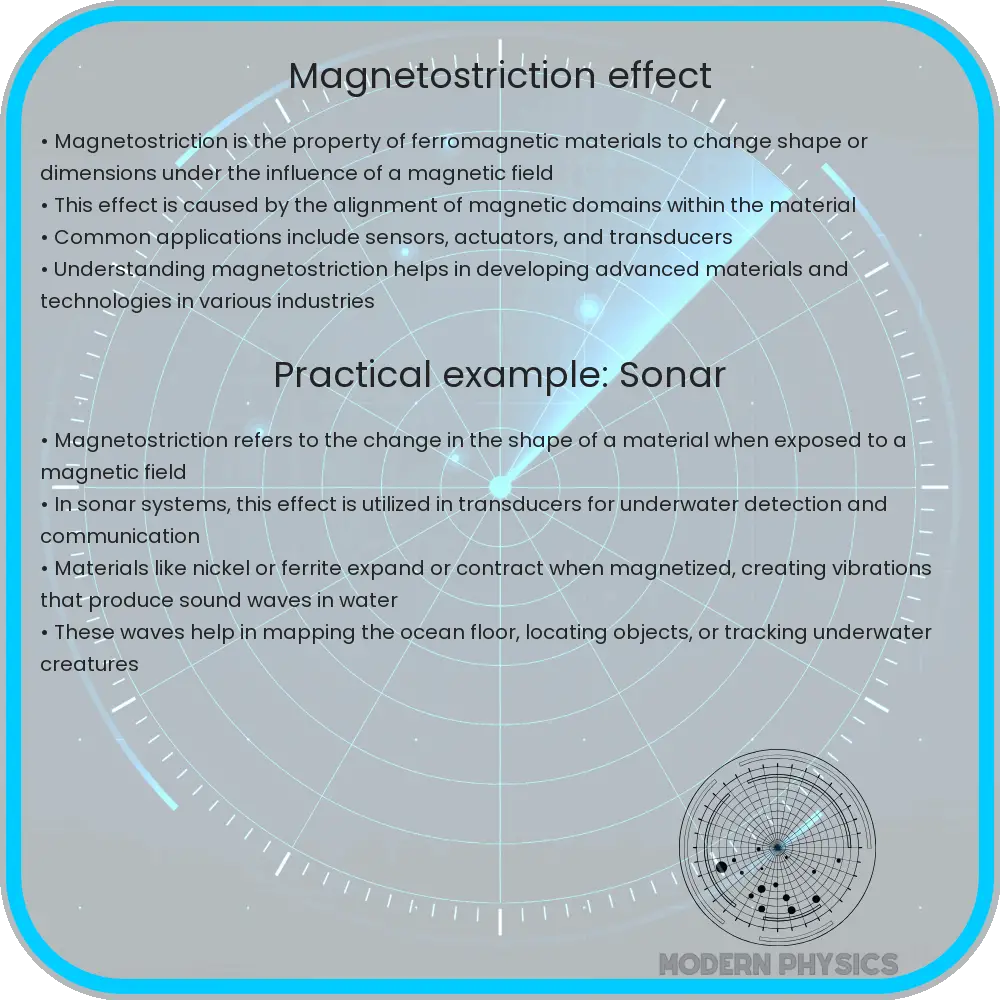Explore the principles, applications, and future of magnetostriction effect, a key phenomenon in magnetic material science and technology.

Magnetostriction Effect: Understanding the Fundamentals
Magnetostriction, a remarkable phenomenon where magnetic materials change their shape or dimensions during the process of magnetization, has been a subject of scientific curiosity and practical application for over a century. This effect is fundamentally linked to the coupling of magnetic and lattice systems within certain materials. When a magnetic field is applied to a magnetostrictive material, the alignment of magnetic domains occurs, leading to a change in the material’s physical dimensions.
Principles of Magnetostriction
The underlying principle of magnetostriction revolves around the concept of magnetic domain realignment. In the absence of an external magnetic field, the domains in a magnetostrictive material are randomly oriented. Upon the application of a magnetic field, these domains tend to align themselves along the field, causing a strain within the material. This strain can either be positive or negative, leading to an expansion or contraction of the material. The magnitude of magnetostriction is quantified by the magnetostriction coefficient, denoted as λ, which is defined as the fractional change in dimension per unit of magnetization.
Applications of Magnetostriction
- Actuators and Sensors: The most prominent application of magnetostriction is in the development of high-precision actuators and sensors. These devices exploit the dimensional change in materials upon magnetization to convert magnetic energy into mechanical energy and vice versa.
- Energy Harvesting: Magnetostrictive materials are also used in energy harvesting applications. They can convert mechanical energy, such as vibrations or oscillations, into electrical energy, providing a sustainable source of power for various applications.
- Magnetic Field Detection: Due to their sensitivity to magnetic fields, magnetostrictive materials are used in devices for detecting and measuring magnetic fields, which is crucial in various industrial and scientific applications.
Analysis of Magnetostriction
Analyzing the magnetostriction effect involves understanding the behavior of materials under different magnetic fields and mechanical constraints. The Joule effect and the Villari effect are two key phenomena associated with magnetostriction. The Joule effect describes the change in length of a material in response to a magnetic field, while the Villari effect refers to the change in the magnetic susceptibility of a material due to an applied stress. Advanced techniques such as neutron diffraction and magneto-optical methods are employed to study these effects in detail, providing insights into the atomic and molecular interactions driving magnetostriction.
Advanced Applications and Future Directions
Magnetostriction technology continues to evolve, opening new avenues for advanced applications. In telecommunications, magnetostrictive materials are used in filters and resonators due to their ability to generate and respond to high-frequency vibrations. In the field of medical technology, they find applications in high-precision surgical instruments and diagnostic devices. Another promising area is in the development of smart materials and structures, where magnetostrictive components can adapt and respond to changing environmental conditions.
Challenges in Magnetostriction
Despite its numerous applications, the practical utilization of magnetostriction faces several challenges. The efficiency and effectiveness of magnetostrictive materials are often limited by factors such as hysteresis, temperature sensitivity, and material fatigue. Overcoming these challenges requires ongoing research and development, particularly in material science, to discover and engineer new magnetostrictive compounds with improved properties.
Environmental Impact and Sustainability
As with any technology, the environmental impact of producing and utilizing magnetostrictive materials is a significant concern. The mining and processing of rare-earth elements, commonly used in high-performance magnetostrictive materials, pose environmental and sustainability challenges. Efforts are being made to find more sustainable alternatives and to improve the recycling processes for these materials.
Conclusion
The magnetostriction effect represents a fascinating intersection of physics and engineering, offering a unique mechanism for converting magnetic energy into mechanical energy and vice versa. Its applications, ranging from precise actuation and sensing to energy harvesting, underscore its importance in modern technology. While challenges in material properties and environmental impact persist, ongoing research and development promise to enhance the capabilities and sustainability of magnetostrictive materials. As we continue to explore the potential of these materials, magnetostriction is poised to play an increasingly vital role in technological advancements and innovation.
